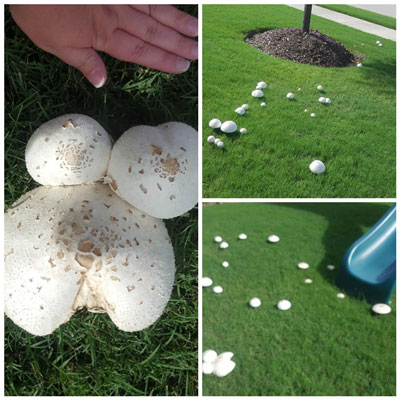Question of the Week: August 24, 2017
“Neil, how come we have so many mushrooms all of a sudden after the rains last week? Are they harmful? If so, how do I get rid of them?”
This is one of the most recent photos that has been posted to my Facebook page. It wasn’t the first (by about 250), and I’m sure it won’t be the last. Here are the facts I try to tell everyone about mushrooms and toadstools.

Photo posted by Jenny M. to my Facebook page a few days ago. Her home is six years old, and these mushrooms are probably living off old wood that was buried during the construction.
• These are saprophytic funguses. They gain their sustenance off decaying organic matter (building debris, old tree roots, grass clippings, etc.). They are in no way parasitic to living plants.
• Mushrooms come and go away very quickly. They spring up almost overnight. Their spore masses are borne beneath their caps and are shed as the plants mature.
• The spores are cast in ever-increasing circles (like ripples on a still pond), and that’s what accounts for the circular pattern of their development known as “fairy rings.” You can see a couple of examples of that in the photo associated with this story.
• Unless you are a highly skilled mycologist (that part of botany that deals with funguses), you are probably not qualified to decide whether these are edible or not. Some mushrooms are quickly deadly. Don’t take that chance. If you’re craving mushrooms for supper, go to the grocery.
• If you want to eliminate mushrooms growing in your landscape or garden, just snap them off with your foot or with a hoe or a rake. They offer almost no resistance.
• Yes, you can expect them to reappear in generally the same places next year, but as the organic matter supply deteriorates, their numbers will wane.
• For most of us, mushrooms are curious novelties we enjoy seeing in our gardens much as we enjoy bumblebees and warty old frogs. We have fun looking at them, and we pretty much leave them alone.
